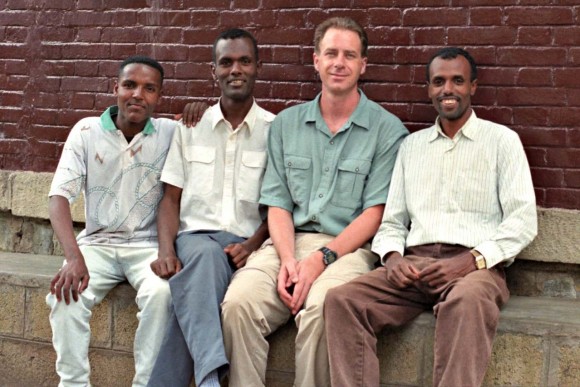009 – Traveller as Baby Bird
My first full day in Ethiopia began with a savage hunger, and I timidly entered the roar of activity in the small room that served as the Palm’s restaurant. People poured in and out and none were strangers. They burst in with laughter and shouts, greeting everyone with a complicated series of handshakes, hugs and even kisses – three on each cheek. Shouts of “enebla!” (Join us!) rang out, and no one could sit down without first sampling a little bit of food from each table they passed. I felt like I was in a village, not a city of 4 million people.
I claimed a spot at one of the wobbly tables, and then found myself quite at a loss. I watched how other people got their food, but I could detect no system. Everyone just seemed to know everything by osmosis. There were no menus on the table or on the walls. I didn’t know which of the women swirling past me were the waitresses, and I couldn’t have spoken to them even if I knew who to address. And I wouldn’t have known what to order anyway. I had no idea what Ethiopian food consisted of.
Finally, I got a girl’s attention and with a phrasebook tried to order something. She simply shook her head and walked away. No help there. A man eating at another table told me in English that the dish I’d asked for was only available on fasting days, Wednesdays and Fridays. With his help I managed to place an order.
In fact, all the meals seemed to follow the same basic pattern and were based on a unique Ethiopian pancake-like bread called enjera. It’s the strangest stuff you can imagine. It’s made like pancake batter and poured onto a hot griddle. It bubbles completely and ends up with a rubbery texture and a sour/tangy taste. My enjera was cut into long strips about 4 inches wide and rolled up like a tube. It came with a pile of meat in the middle. Vegetarianism is not a concept easily swallowed here. The idea is to tear off pieces of enjera, wrap it around whatever sauce (or “wat”) came with it and eat it. My first touch of the enjera made me giggle. Cold rubber sponge gone sour.
I ate enjera two or three times a day my entire stay in Ethiopia, but I never quite mastered the dexterity of the Ethiopians. They neatly pulled together a large mound of enjera and wat, rolled it into a ball balanced neatly on three or four fingers, and then popped it into their mouths with their thumbs. Fingers and thumbs never really came into contact with lips or mouth. By comparison I must have looked like some slobbering caveman. My balls of enjera and wat never quite held together and I ended up having to jam my fingers into my mouth to keep everything from falling into my lap.
Eating was a social occasion and hospitality points were scored by urging others to eat more. It was considered polite to tear off large hunks of enjera from your side and put them on the tray in front of other people. A special mark of friendship was to take a choice fingerful of food and literally feed it to someone else. It was a very intimate thing to do as I discovered.
I constantly found myself in trouble because my amateurish balls of enjera were so small and I ate so slowly. My companions would feel distressed that the foreign guest did not seem to be enjoying the meal as much as he should. “Eat,” they’d urge. I’d be stuffing food into my mouth as fast as I could, but it was never enough. “Please eat,” they’d plead and the pile of food in front of me would grow to alarming proportions. “Why don’t you eat?” they’d ask with hurt eyes. “I am eating!” I’d say, but my protest would fall on deaf ears, and they’d exert themselves to assemble the tastiest mounds of enjera and wat and feed me by hand themselves. The portions they offered would be so large my jaws would ache with the effort of opening my mouth so wide. I took a mental picture the first time it happened and called it “Traveller as Baby Bird.”
Tags: Ethiopia, Ethiopia Bike Trip

